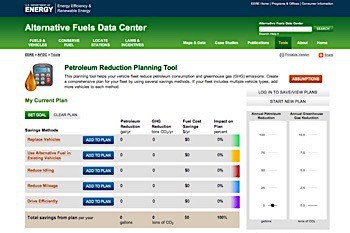The U.S. Department of Energy’s National Renewable Energy Laboratory (NREL) has released an updated website and a new interactive application to assist fleet managers in how they select viable alternative fuels and energy efficiency strategies for reducing petroleum usage.
The Alternative Fuels Data Center (AFDC) now includes a new Petroleum Reduction Planning Tool for private companies and municipalities that allows fleet managers to evaluate the benefits of biodiesel, plug-in and hybrid-electric drive trains, natural gas and propane for school buses. It also allows fleets to evaluate ethanol for other vehicles.
“Fleets across the country are trying to reduce their vulnerability to spikes in oil prices and are finding themselves increasingly subject to greenhouse gas (GHG) emissions limitations at the federal, state and local levels,” said Witt Sparks, the project manager at NREL. “This tool provides valuable information on a variety of strategies that can help them reach their desired and even required outcome.”
From a single web page, the planning tool enables fleet managers to explore multiple strategies and “what-if” scenarios to determine what the energy and environmental impacts will likely be before making what Sparks called “substantial investments” in infrastructure. For example, if fleet managers are considering replacing existing diesel school buses with propane buses, they can see how much fuel and money can be saved. The app allows users to input a certain number of current vehicles in the fleet, say five conventional diesel school buses with a GVWR of at least 26,000 pounds. Users can input current miles per gallon attained, for example 6 mpg, as well as the current miles traveled per yer per vehicle, for example 100,000 miles. Users can then input the number of new vehicles being purchased, say five propane school buses with 9 mpg each, that will replace the five diesel buses.
Using that data equates to a petroleum reduction of 93,667 gallons a year, 729 tons of reduced GHG per year and a fuel savings cost of $165,800/year.
Similarly, web users can calculate the use of alternative fuel in existing vehicles, reduced idling, reduced mileage and cost benefits of more efficient driving patterns. For example, a fleet that currently idles a conventional diesel bus for two hours total each day and that seeks to reduce that number to one hour total per day can expect to save more than $405 a year per bus, reduce 121 gallons of petroleum used and decrease GHG emissions by two tons a year.
Plans can be saved, adjusted as necessary and addditional scenarios can be created. The tool also provides charts and tables that display annual reductions in emissions, petroleum usage and fuel costs, and links to background information and other resources are provided.
Meanwhile, the redesigned AFDC website, a resource of the Department of Energy’s Clean Cities program, includes a new library of maps and data so users can view and customize interactive charts and graphics on alternative fuel usage trends, driving habits, hybrid vehicle availability, biofuels production, transportation regulations and incentives, and vehicle GHG emissions. The Alternative Fueling Station Locator was also updated to allow for users to embed results on their own websites.
The AFDC site also features a large collection of case studies in alternative transportation deployment, both in article and video formats.
“These stories serve as road maps for fleets and driers, so they can learn how others overcame barriers and found success,” added Trish Cozart, the AFDC manager. “Users can find real-life examples of fleets that run on biodiesel, cities that have developed electric-vehicle charging infrastructure and school districts that power their buses with propane.”
In related news, Blue Bird also displayed a new propane calculator on the NAPT Summit trade show floor in Memphis, Tenn., and a new natural gas fleet savings calculator was scheduled to be released on Nov. 26 to the public by the American Gas Association’s Drive Natural Gas Initiative.


















